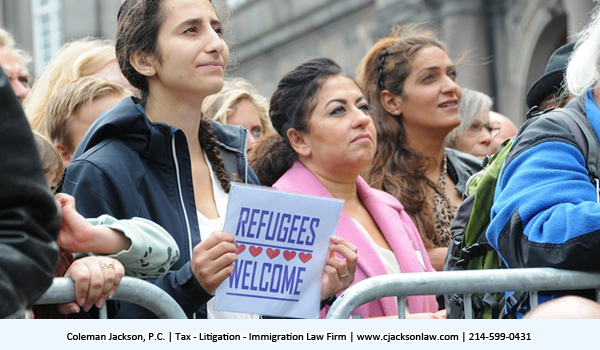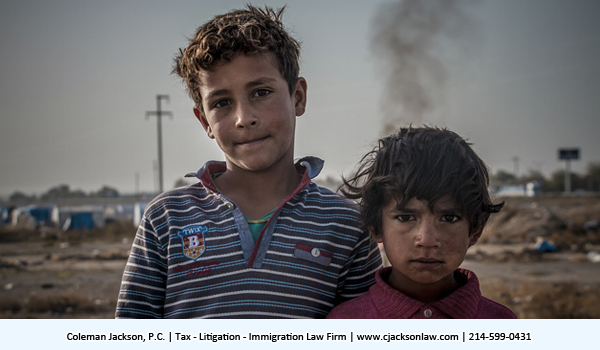By Coleman Jackson, Attorney & Counselor at Law
November 29, 2021
Every year people come to the United States seeking protection because they have suffered persecution or fear that they will suffer persecution in their home country due to race, religion, nationality, membership in a particular social group, and political opinion. There are many reasons why people around the globe seek to rebuild their lives in a different country. Some people leave home to get a job or an education. Others are forced to flee their homes due to persecution or human rights violations; such as, torture, wars, famines, and domestic violence. Millions flee their native lands each year due to armed conflicts or other human-made crises or natural violence, climatic disasters and upheaval. Some no longer feel safe at home and might have been targeted just because of who they are or what they do or what they believe – for example, many people have been targeted for persecution, torture and other forms of unspeakable human rights abuse because of their ethnicity, religion, sexuality, or political opinions.
What is Asylum?
Asylum is a protection in the law granted to foreign nationals already in the United States or arriving at the border who meet the international law definition of a “refugee.” The United Nations 1951 Convention and 1967 Protocol define a refugee as a person who is unable or unwilling to return to his or her home country: A refugee cannot obtain protection in their home country due to past persecution or a well-founded fear of being persecuted in the future “on account of their race, religion, nationality, membership in a particular social group, or political opinion. ”The United States Congress incorporated this definition of a ‘refugee’ into U.S. immigration law in the Refugee Act of 1980.
Asylum affords more protections than withholding of removal. For example, those granted asylum are allowed to work, bring their immediate families to the United States, apply for a Social Security card, request permission to travel overseas, and access public assistance, such as Medicaid or Refugee Medical Assistance. Asylees also have a routine mechanism for adjusting to permanent resident status after one year in the United States. Once the individual becomes a permanent resident, he or she must wait four years to apply for citizenship. On the other hand, those granted withholding of removal due to the likelihood of either persecution or torture remain in a tenuous position. They can be removed at any time to a willing third country, though such offers rarely materialize. Also, they can work and sometimes receive public assistance but they cannot bring their immediate families to the United States. There is no provision for eventual adjustment of status to lawful permanent resident for immigrants granted withholding of removal status.
Both asylum and withholding of removal are filed on the same application (Form I-589). Asylum claims must generally be filed within one year of arrival in the United States, but there is no deadline for filing a withholding of removal application. Form I-589 (available on the USCIS Forms website) asks why the applicant is seeking protection and what he or she thinks would happen upon return to their home country. In addition, the form requires other information that may throw further light on the claim, such as past activities and organizational affiliations, current whereabouts and condition of family members, and the circumstances of departure and travel to the United States. Many applicants provide additional material, sometimes voluminous, including affidavits, news accounts, or human rights reports, including those from non-governmental organizations like Amnesty International or Human Rights Watch. There are extreme consequences for filing a frivolous asylum application. Word to the wise; be careful and meticulously comply with Form I-589 Instructions.
What is persecution?
To persecute means to harass, punish, injure, oppress, or otherwise cause someone to suffer physical or psychological harm.
U.S. immigration law does not list specific examples of the kinds of persecution that would qualify someone for asylum or refugee status. However, from the law that has been developed through court cases, we know that it can include such acts as threats, violence, torture, inappropriate imprisonment, or denial of fundamental human rights or freedoms.
Historically, for example, the need for asylum or refugee status has been recognized in situations where a foreign government has:
- imprisoned and tortured political dissidents or supposed undesirables
- fired weapons on protesters
- committed genocide against a particular race
- made sure that members of a specific religion were left out of the political process,
- and much more.
Remember that the persecution must be connected to one of five grounds—race, religion, nationality, membership in a social group, or political opinion. So, for example, violence directed against gays and lesbians is recognized as persecution connected to membership in a social group. But violence against an individual who happens to have angered a local criminal might not have the necessary connection to one of the five grounds making it much more difficult for victims fleeing their countries due to criminal gangs to be eligible for asylum or refugee status from the U.S. government. The U.S. government has recognized persecution based on gender as falling in the “particular social group” category for purposes of asylum. This recognition of gender persecution and domestic violence victims as a particular social group has in recent years permitted domestic abuse victims the opportunity to seek protection as refugees by filing an asylum application in the United States. Also remember that asylum applicants fear of future persecution in their home country must be “well-founded.” This is an objective standard of fear; will a reasonable person similarly situated fear for their health, limb and life?
Recent Developments in U.S. Asylum Policies and Practice:
Work Authorization Delayed:
Until about the middle of 2020, most asylum applicants received work authorization while their asylum cases were pending decision at the asylum office. Once more than 180 days prescribed by statute had passed after submitting their applications, asylum applicants were issued one year work permits. However, in June 2020, the Department of Homeland Security changed this work permit rule. The DHS promulgated a new regulation prohibiting work authorization for 365 days after filing an asylum application and banning employment authorization for all asylum seekers who did not enter at a port of entry. Concurrently with its regulation to restrict asylum for all who did not enter at a port of entry, DHS took steps to limit the number of individuals who could file asylum applications at ports of entry. Subsequently, the United States suspended all asylum applications indefinitely due to COVID-19. As a result, the asylum offices and the immigration courts have monumental backlogs, causing applicants to wait months and years to adjudicate their claims. Affirmative asylum applications can be pending in the asylum office for years. Anyone seeking asylum in the United States must factor in the real possibility that they will not be able to work lawfully in the United States under current U.S. asylum policies and practices for well over 1 to 1.5 years after the asylum office accepts their application for processing.
However, you may be eligible to receive employment authorization based on a pending asylum application if you meet one or more specific requirements. As in all immigration matters, policies and implementation priorities might change; these changes might impact which asylum applicants can be eligible for work authorizations and when they can apply for work authorization.
Review of Asylum Application Approval History:
Asylum officers have the authority to grant asylum to asylum applicants who satisfies the statutory standards. In the past, positive asylum decisionsran between 15 and 30 percent of affirmative asylum application filings. In 2013 asylum officers approved close to 50 percent of all affirmative asylum applications. The approval rate hovered near 20 percent in 2015 and 2016; the asylum application approval rate plummeted to approximately 10 percent in 2016 and 2017, and returned to roughly 20 percent in 2018 and 2019. See these approval rate statistics in the U.S. Citizenship & Immigration Servs., All Forms, Annual Reports, 2013–2019.
Summary: File a Credible Asylum Application:
Even if you think you’re eligible for asylum or refugee protection in the United States; that is, you’ve experienced persecution based on one of the five grounds we have discussed in this blog; you still need to prepare an asylum application; but you must also supplement this application with evidence proving your claim for asylum. You can substantiate your claim for asylum in the U.S. with your own testimony, statements by witnesses, newspaper articles and other reports discussing your case or the human rights situation in your country, expert witness statements and opinions and other credible and germane evidence.
This law blog is written by the Taxation | Litigation | Immigration Law Firm of Coleman Jackson, P.C. for educational purposes; it does not create an attorney-client relationship between this law firm and its reader. You should consult with legal counsel in your geographical area with respect to any legal issues impacting you, your family or business.
Coleman Jackson, P.C. | Taxation, Litigation, Immigration Law Firm | English (214) 599-0431 | Spanish (214) 599-0432 | Portuguese (214) 272-3100





